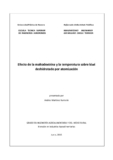Mostrar el registro sencillo del ítem
Efecto de la maltodextrina y la temperatura sobre kiwi deshidratado por atomización
| dc.creator | Martínez Iturralde, Andrea | es_ES |
| dc.date.accessioned | 2015-11-23T10:33:33Z | |
| dc.date.available | 2015-11-23T10:33:33Z | |
| dc.date.issued | 2015 | |
| dc.identifier.uri | https://hdl.handle.net/2454/19400 | |
| dc.description.abstract | Actualmente, las frutas como el kiwi son apreciadas por los consumidores entre otras cosas debido a su alto contenido nutricional. Aunque suelen consumirse en fresco, al ser una fruta perecedera y estacionaria, frecuentemente se procesa para alargar su vida útil, como zumos, productos deshidratados, etc. La atomización es la técnica más utilizada para obtener fruta en polvo, obteniendo un producto de alta calidad, facilitando el transporte y el almacenamiento. Sin embargo, la atomización de frutas ricas en azúcares y ácidos, como el kiwi, es complicada debido a su baja temperatura de transición vítrea (Tg) lo cual hace que el producto se adhiera en las paredes del equipo. Para minimizar este problema, se trabaja con bajas temperaturas y añadiendo agentes transportadores, para aumentar la Tg, siendo el más utilizado la maltodextrina. El objetivo de este estudio es obtener kiwi deshidratado en polvo a partir de subproductos de kiwi mediante atomización, además de evaluar las diferentes propiedades físico-químicas (humedad, aw, rehidratación, solubilidad, higroscopicidad y rendimiento, entre otras), y para determinar su valor nutricional después de las diferentes condiciones de procesado. Se estudió el efecto de 30 %, 40 % y 50 % de maltodextrina en el producto final y diferentes temperaturas del aire (135 ᵒC y 150 ᵒC). La calidad general de los kiwis deshidratados parecía depender en gran medida de las condiciones de procesamiento, obteniendo las mejores características del producto con la mayor cantidad de maltodextrina y menor temperatura. | es_ES |
| dc.description.abstract | Nowadays, fruits like kiwifruit are highly appreciated by consumers among other things for their high nutritional value. Although kiwifruits are usually consumed as fresh products, they are seasonal and highly perishable and, therefore, they are frequently processed to obtain longer shelf-life products, such as juice, dehydrated products, etc. Spray-drying is the most commonly technique to manufacture fruit powder, a high-quality product being obtained, and facilitating transport and storage. However, the spray-drying of fruits with high contents of sugars and acids, such as kiwifruit, is complex due to low glass transition temperature (Tg) and the fact that, during spray-drying, the product sticks on the walls of the equipment. To minimize this problem, working at low temperatures and adding carrying agents, increases the Tg. The most used carrier is maltodextrin. The aim of the present study was to obtain dehydrated kiwifruit powder from kiwi by-products using spray-drying, in order to evaluate different chemical and physical quality indicators (humidity, aw, rehydration ratio and time, solubility, hygroscopicity and yield, among others), and to determine their nutritional value after different processing conditions. The effects of 30%, 40% y 50% of maltodextrin on the final product and different air-temperatures were studied. The best characteristics of the product were achieved with the highest amount of maltodextrin and the lowest temperature. Overall quality of dehydrated kiwifruits seemed to be greatly dependent on processing conditions, achieving the best characteristics of the product with the highest amount of maltodextrin and the lowest temperature. | en |
| dc.format.mimetype | application/pdf | en |
| dc.language.iso | spa | en |
| dc.subject | Kiwi | es_ES |
| dc.subject | Atomización | es_ES |
| dc.subject | Deshidratación | es_ES |
| dc.subject | Maltodextrina | es_ES |
| dc.subject | Temperatura de transición vítrea (Tg) | es_ES |
| dc.subject | Kiwifruit | en |
| dc.subject | Spray-drying | en |
| dc.subject | Dehydration | en |
| dc.subject | Maltodextrin | en |
| dc.subject | Glass transition temperature (Tg) | en |
| dc.title | Efecto de la maltodextrina y la temperatura sobre kiwi deshidratado por atomización | es_ES |
| dc.type | Trabajo Fin de Grado/Gradu Amaierako Lana | es |
| dc.type | info:eu-repo/semantics/bachelorThesis | en |
| dc.date.updated | 2015-11-03T07:58:44Z | |
| dc.contributor.affiliation | Escuela Técnica Superior de Ingenieros Agrónomos | es_ES |
| dc.contributor.affiliation | Nekazaritza Ingeniarien Goi Mailako Eskola Teknikoa | eu |
| dc.description.degree | Graduado o Graduada en Ingeniería Agroalimentaria y del Medio Rural por la Universidad Pública de Navarra | es_ES |
| dc.description.degree | Nekazaritzako Elikagaien eta Landa Ingurunearen Ingeniaritzan graduatua Nafarroako Unibertsitate Publikoan | eu |
| dc.rights.accessRights | Acceso embargado 5 años / 5 urteko bahitura | es |
| dc.rights.accessRights | info:eu-repo/semantics/embargoedAccess | en |
| dc.contributor.advisorTFE | Arroqui Vidaurreta, Cristina | es_ES |
| dc.contributor.advisorTFE | Cantalejo Díez, María Jesús | es_ES |


